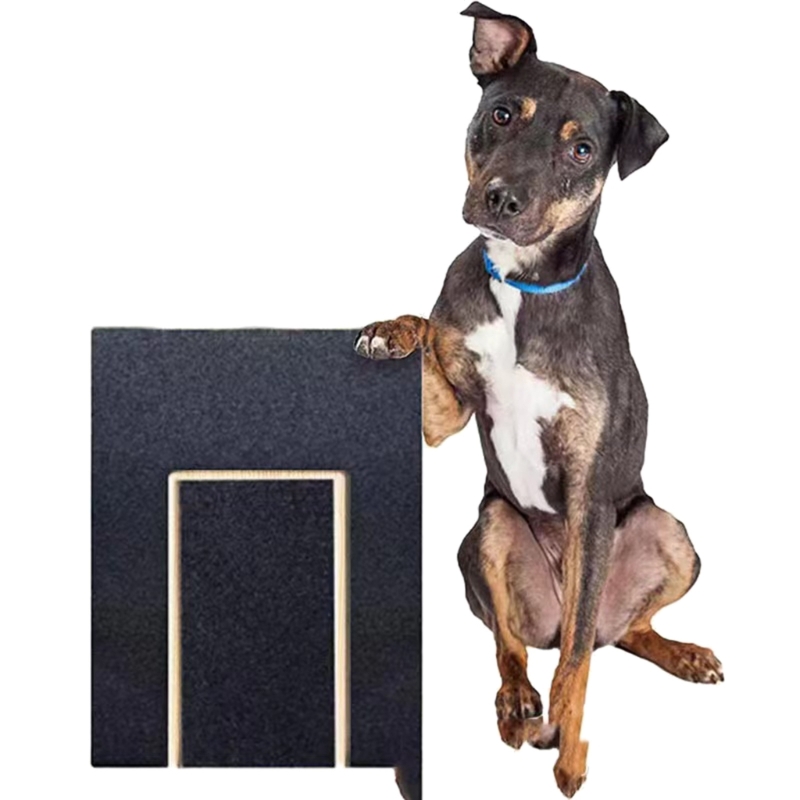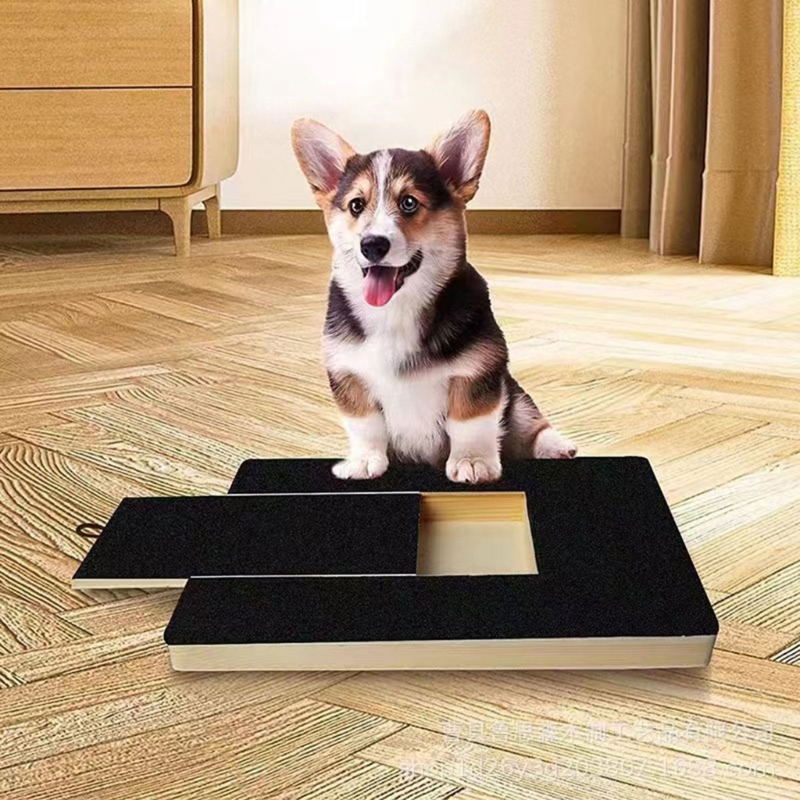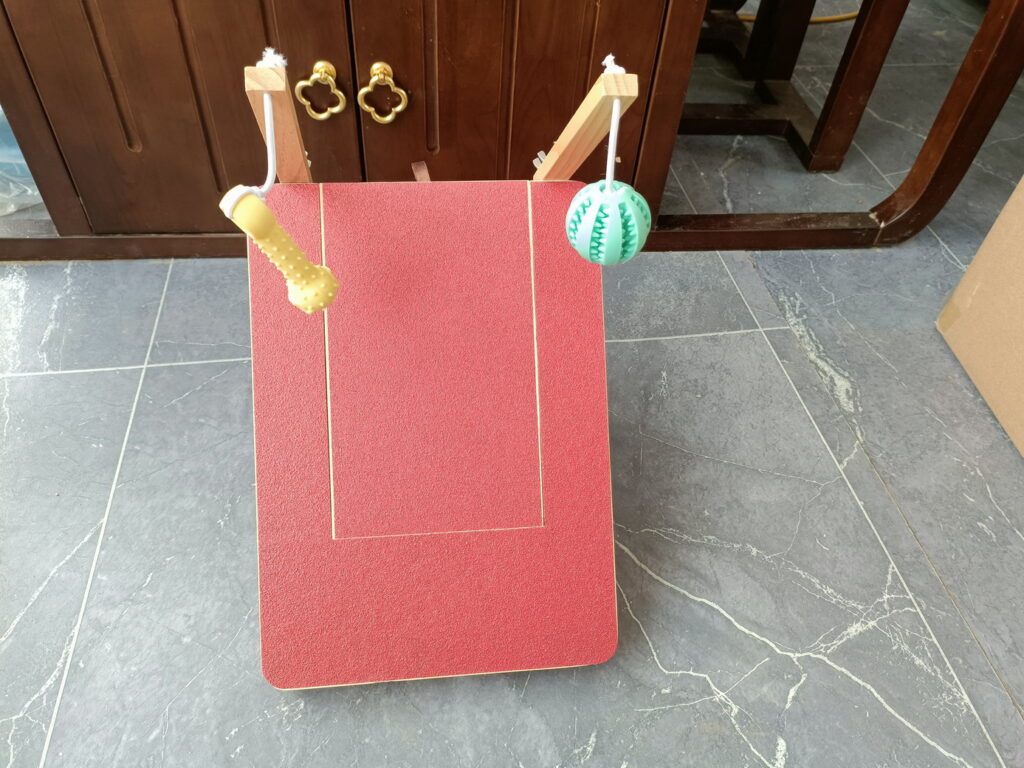Dog Nail Scratch Board
Have you ever wondered if there’s a more enjoyable and stress-free way to maintain your dog’s nails? As a responsible dog owner, you know that keeping your furry friend’s nails trimmed is crucial for their comfort and health. Proper nail maintenance prevents common issues such as pain, infection, and mobility problems. But did you know there are two primary methods for keeping your dog’s nails in check: using a dog nail scratch board and traditional clipping? In this blog post, we’ll explore the pros and cons of each method, providing you with the information needed to make an informed decision for your beloved pet.

Understanding Dog Nail Care
Regular nail care for dogs is more important than many pet owners realize. Overgrown nails can lead to a host of issues, including pain when walking, changes in gait, and even more severe problems like infections and joint damage. Just as humans need regular nail trimming, dogs require consistent nail maintenance to stay healthy and comfortable.
Neglecting nail care can cause a dog’s nails to curl under and grow into their paw pads, leading to painful and potentially infected sores. Additionally, long nails can cause a dog to slip on smooth surfaces, increasing the risk of injury. Regularly checking and maintaining your dog’s nails helps to avoid these problems and ensures your pet’s overall well-being.
Dog nail care isn’t just about aesthetics; it’s a vital part of their health regimen. When nails become overgrown, they can interfere with the dog’s natural gait, leading to skeletal problems over time. Long nails can split and break, which is not only painful but can also lead to infections. Keeping your dog’s nails at an appropriate length ensures that they can move comfortably and reduces the risk of related health issues.
What is a Dog Nail Scratch Board?
A dog nail scratch board, also known as a dog nail file board or scratch pad for dogs, is a specially designed tool that helps dogs naturally file down their nails. These boards typically feature a coarse surface, such as sandpaper, attached to a sturdy backing. As dogs scratch against the board, their nails are filed down gradually and safely.
There are various designs of dog nail scratch boards available on the market. Some are flat and placed on the ground, while others can be propped up against a wall. Some advanced versions even come with treat dispensers, like the dog nail scratch board with treat, to encourage dogs to use the board. Using a scratch board can be a fun and engaging way for dogs to maintain their nails, often turning grooming into a game.
Homey Panda‘s Dog Nail Scratch Board is a very popular choice among pet owners. It features durable construction and a built-in treat dispenser, making it an effective and enjoyable tool for dogs. Homey Panda‘s Upgraded version is enhanced with an exciting new feature to set it apart from the competition—two engaging dog toys! This innovative addition not only boosts usability but also amps up the fun factor. With these toys, your dog will be encouraged to play and interact, naturally increasing their scratching activity. Training a dog to use a nail scratch board involves positive reinforcement. By rewarding your dog with treats or kibble when they scratch the board, you can make the experience enjoyable and stress-free. Over time, most dogs learn to associate the board with positive outcomes, making it a useful tool for ongoing nail maintenance.

Traditional Clipping: What You Need to Know
Traditional nail clipping involves using clippers specifically designed for dogs to trim the nails manually. This method requires precision and care to avoid cutting the quick—the sensitive part of the nail that contains blood vessels and nerves. Tools needed for traditional clipping include a pair of high-quality dog nail clippers and, optionally, a styptic powder to stop any bleeding if the quick is accidentally cut.
Clipping your dog’s nails should be done with proper technique to ensure safety and effectiveness. It’s important to hold the paw firmly and clip small sections of the nail at a time. Keeping the clipping sessions short and positive, with plenty of treats and praise, can help your dog feel more comfortable.
While traditional clipping is a straightforward method, it does have its challenges. Some dogs may be fearful or resistant to having their nails clipped, making the process stressful for both the pet and the owner. Additionally, improper clipping can result in injury if the quick is cut, causing pain and bleeding. Despite these challenges, many pet owners find traditional clipping to be an effective way to maintain their dog’s nails when done correctly.
Pros and Cons of Dog Nail Scratch Boards
Using a dog nail scratch board has several benefits. One of the primary advantages is that it allows dogs to file their nails naturally, mimicking the effect of walking on rough surfaces. This method can be less stressful for dogs who are anxious about traditional clipping, as it turns nail maintenance into a game rather than a chore.
A significant benefit of scratch boards, such as the dog nail file board scratch pad treat box, is that they often come with treat dispensers, making the process enjoyable for the dog. This positive reinforcement encourages dogs to use the board consistently. Additionally, scratch boards can be particularly useful for dogs with hard nails that are difficult to trim with clippers.
However, there are some drawbacks to consider. Not all dogs may take to using a scratch board immediately, requiring patience and consistent training. Also, scratch boards may not be as effective for all breeds or nail types, particularly if the dog’s nails are extremely thick or overgrown. While they can be a great supplementary tool, they might not completely replace traditional clipping for every dog.

Pros and Cons of Traditional Clipping
Traditional clipping has its own set of advantages. It allows for precise control over how much of the nail is trimmed, which is particularly important for dogs with very overgrown nails. With proper technique, traditional clipping can be quick and efficient, making it a preferred method for many pet owners.
However, there are challenges and risks associated with traditional clipping. Some dogs are very sensitive about having their paws handled, making the process difficult and stressful. There is also the risk of cutting the quick, which can cause pain and bleeding. For these reasons, it’s essential to approach clipping with care and patience, and to use high-quality clippers designed for dogs.
Traditional clipping might be ideal for dog owners who are confident in their technique and whose dogs are comfortable with the process. However, for dogs that are anxious or resistant, alternative methods like scratch boards might be a better option.

Training Your Dog to Use a Nail Scratch Board
Training your dog to use a nail scratch board involves patience, consistency, and positive reinforcement. The initial steps include introducing the board in a non-threatening manner and associating it with positive experiences. Start by placing the board on the ground and allowing your dog to explore it. Encourage them to scratch by placing treats on or near the board.
Consistency is key. Regular, short training sessions can help your dog get used to the board. For instance, using a dog nail scratch board with treat can make the training process smoother. The treats motivate the dog to scratch the board, gradually filing down their nails.
Case studies like Eileen Anderson’s experience highlight common mistakes and solutions. Anderson initially trained her dogs in a somewhat haphazard way, but she eventually developed effective methods for ensuring even nail wear. By learning from her experiences, you can avoid similar pitfalls and make the training process more efficient.
Switching Feet: Ensuring Even Nail Wear
One critical aspect of using a nail scratch board is ensuring that your dog uses both feet evenly. This prevents uneven nail wear and promotes balanced nail maintenance. Encouraging your dog to switch feet can be achieved through various methods, such as treat placement and specific training cues.
For example, Clara’s experience, as detailed by Anderson, shows how treat placement can influence which foot the dog uses. By tossing the treat to one side, you can prompt your dog to use the other foot when they return to the board. Similarly, using different cues for each foot can help train your dog to switch feet systematically.
These methods ensure that your dog’s nails are filed evenly, preventing issues associated with uneven wear. The process requires patience and consistency, but the results are worth the effort.

Advanced Training Techniques for Scratch Boards
Once your dog is comfortable using a scratch board, you can introduce advanced training techniques to enhance their experience and nail care efficiency. One such method is the “Digging” approach, where dogs are encouraged to dig at the board, using both feet in a flurry of activity. This technique can be particularly effective for dogs that naturally enjoy digging behaviors.
Another advanced technique involves integrating a Dremel tool with the scratch board. This method, as demonstrated by experts like Susan Garrett, involves using a Dremel to file the tops of the nails after the initial scratch board session. This combination ensures that the nails are filed evenly and thoroughly.
Introducing variety in the training sessions can also keep your dog engaged. For instance, changing the board’s position or the type of treats used can make the sessions more interesting for your dog. The key is to maintain a positive and rewarding experience, ensuring that your dog associates nail maintenance with enjoyable activities.

ance, making it a valuable addition to any pet care routine.
Cost Comparison: Scratch Boards vs. Clippers
When considering the cost of dog nail maintenance methods, both initial and long-term expenses come into play. Dog nail scratch boards, such as the dog nail filing board or dog scratch pad for nails, typically require an initial investment. The cost can vary depending on the quality and features, such as treat dispensers or replaceable sandpaper.
Traditional clippers are generally less expensive initially, but the long-term costs can add up if you need to replace clippers frequently or invest in additional tools like styptic powder. Additionally, if you opt for professional grooming services, the costs can become significant over time.
In terms of value for money, scratch boards can be a cost-effective solution for dogs that take to them well. They offer the added benefit of making nail maintenance a positive and engaging experience for the dog. However, traditional clipping remains a reliable and cost-effective method for many pet owners, particularly those confident in their clipping skills.
Safety Considerations
Safety is a paramount concern when it comes to dog nail maintenance. Whether using a dog nail scratch board or traditional clippers, taking precautions can prevent injuries and ensure a positive experience for your pet.
For scratch boards, ensure that the board is stable and securely placed to prevent it from moving during use. Use the appropriate grade of sandpaper, starting with finer grits and gradually moving to coarser ones as needed. Monitor the condition of the sandpaper and replace it regularly to maintain its effectiveness.
When using traditional clippers, the main safety concern is avoiding cutting the quick. This sensitive area can cause pain and bleeding if cut. To prevent this, trim small sections of the nail at a time and keep a styptic powder on hand to stop any bleeding. Proper restraint and a calm environment can also help reduce the risk of accidents.
Which Method is Best for Your Dog?
Choosing between a dog nail scratch board and traditional clipping depends on several factors, including your dog’s personality, behavior, and your own comfort level with each method. Some dogs may be more anxious about clipping, making a scratch board a better option. Others may have very thick nails that require the precision of traditional clippers.
Consider your dog’s individual needs and preferences. If your dog enjoys interactive activities and is food-motivated, a scratch board with treats can be a fun and effective tool. On the other hand, if you prefer a quick and precise method, traditional clipping might be the way to go.
Ultimately, the best method is the one that works for both you and your dog, ensuring regular nail maintenance without causing stress or discomfort.

Maintaining Your Dog’s Nails Between Sessions
Regardless of the primary method you choose, it’s essential to maintain your dog’s nails between grooming sessions. Regularly inspecting your dog’s nails can help you catch any issues early, such as splits, breaks, or infections.
For those using scratch boards, keeping the board accessible and encouraging your dog to use it frequently can help maintain nail length. Regularly replacing the sandpaper ensures that the board remains effective. Incorporating the scratch board into your dog’s daily routine, such as using it during playtime or training sessions, can make maintenance easier and more consistent.
For traditional clipping, setting a regular schedule for nail trims is crucial. Depending on your dog’s activity level and the rate at which their nails grow, you might need to clip them every few weeks. Using a nail file or a Dremel tool between clipping sessions can help smooth out any rough edges and keep the nails at a manageable length.
Common Myths and Misconceptions
There are several myths and misconceptions about dog nail care that can lead to confusion for pet owners. One common myth is that walking on pavement naturally files a dog’s nails enough. While walking on rough surfaces can help wear down nails, it usually isn’t sufficient for overall nail maintenance, especially for dogs that walk primarily on grass or indoors.
Another misconception is that only large or active dogs need regular nail care. In reality, all dogs, regardless of size or activity level, require regular nail maintenance. Small dogs often spend more time indoors and on soft surfaces, which do not wear down their nails as effectively.
Some pet owners believe that their dogs will naturally wear down their nails by using a scratch board without any training. However, introducing and training your dog to use a nail scratch board correctly is essential for it to be effective. Positive reinforcement and consistency are key to ensuring that your dog uses the board as intended.
Product Spotlight: Homey Panda’s Dog Nail Scratch Board
Homey Panda’s Dog Nail Scratch Board has become a favorite among pet owners for its durability and innovative design. This scratch board features high-quality materials and a built-in treat dispenser, making it both effective and enjoyable for dogs. Homey Panda’s Upgraded version is enhanced with an exciting new feature to set it apart from the competition—two engaging dog toys! This innovative addition not only boosts usability but also amps up the fun factor. With these toys, your dog will be encouraged to play and interact, naturally increasing their scratching activity. The board is designed to be easy to use, offering enhanced playtime excitement that no one else provides.
HomeyPanda‘s product stands out due to its thoughtful construction and focus on safety. The stable design prevents the board from moving during use, reducing the risk of accidents. The treat dispenser encourages dogs to use the board consistently, turning nail maintenance into a rewarding activity.
Pet owners who have used Homey Panda’s Dog Nail Scratch Board report positive experiences, noting that their dogs quickly adapted to the board and now enjoy using it. This product offers a convenient and stress-free solution for dog nail mainten
ance, making it a valuable addition to any pet care routine.
Conclusion
In conclusion, both dog nail scratch boards and traditional clipping offer viable solutions for maintaining your dog’s nails. Scratch boards can turn nail maintenance into a fun and engaging activity, particularly for dogs that are anxious about clipping. Traditional clipping, on the other hand, provides precise control and can be done quickly with the right technique.
By considering your dog’s unique needs and preferences, as well as your own comfort level with each method, you can choose the best nail care solution for your furry friend. Regular nail maintenance is crucial for your dog’s health and well-being, so finding the right method is essential.
For more tips and information on dog care, be sure to check out other articles on our blog. Keep your pets happy and healthy!

